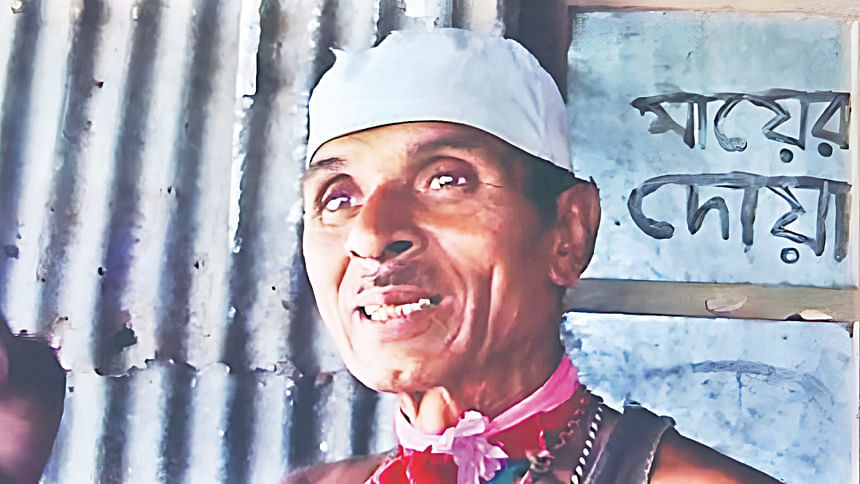When the traditional haor song Lechur Baganey ("In the litchi orchard…") was repurposed as an "item song" in a recent Bengali film, it sparked an outpouring of debate among music lovers and across social media platforms. At the heart of these conversations emerged the name of Sattar Pagla—a mystic folk singer from Mohanganj whose life and music embody the essence of the region. To grasp his true importance, one must step into the world he inhabited: his lived philosophy, his raw musical expression, and his conscious choice to remain rooted within the deeper soil of Bangladesh's folk heritage.
Born in the village of Hironpur in Purbadhala upazila, Netrokona, Sattar Pagla spent his childhood in Lalchapur before settling in Naluar Char, Mohanganj. Since his passing in 2014, an annual Uras has been held in his honour—a reflection of how deeply his songs, lifestyle, and spiritual aura continue to resonate with his community. By the 1980s and '90s, his songs had already travelled far beyond haor lands—he wasn't 'discovered' by a filmmaker yesterday.
Sattar Pagla's music was an extension of the lives around him. He sang of families and dreams, of poverty and protest, of laughter and longing. His songs echoed through railway stations, train compartments, village gatherings, and festive evenings—not concert halls. His raw, unamplified voice was often accompanied by handmade instruments crafted from leaves, bamboo, or broken toys—a birdlike realism that favoured truth over polish.
Adorned with garlands, bangles, caps, and turbans, he looked every bit the earthy, vibrant spirit of the folk singer. His performances blurred the line between artist and audience, heavy with improvisation and emotional immediacy. Songs like Harveja Re/Ball Khelada tauba kore char... ("Give up playing ball...") warned the youth against recklessness, layered with philosophical undertones—just as a ball needs air to keep its shape, so too does the body depend on breath.
Music was a family affair. His daughters often joined him in song, while he composed originals and reinterpreted traditional pieces. One such example is Lechur Baganey—a song not just performed but transformed by Sattar Pagla. Through his lyrical and melodic touch, it became his own. In the haor, his version is the version.
Folk music is not frozen in time—it flows through generations, reshaped by memory and community. It survives not through scripts, but through voices like Sattar Pagla's, who become living bridges between the past and the present. He was not just a singer, but a cultural archetype of the haor region, carrying forward the legacy of Rashid Uddin, Jalal Khan, and Ukil Munshi.

His songs often seemed to drift from the skies over the wetlands—natural, unforced, and filled with feeling. In Kangal Mere Jangal Dile Guna Hoiba Tor ("Killing the poor to plant trellised greens will add to your sin…"), he gave voice to the pain of the powerless. In Shapla Banu, he spun a pastoral dream rooted in myth and reality—milk without a calf, a village's miracle.
Traditional folk music is inherently adaptable. Its lyrics and delivery shift with audience and time. In Dinga Pota Bondh..., Sattar would change names and places mid-performance, making every rendition feel personal and alive. This participatory spirit turned his songs into communal property, shared by singer and listener alike.
Ethnomusicologist Timothy Rice reminds us that traditional music is not merely an art form—it is a social and cultural process, a vessel of memory and identity. Sattar Pagla embodied this philosophy. His creative reinterpretation of Lechur Baganey, though now commercialised, was part of a living tradition. His voice, memory, and artistry helped preserve and transform it for the present generation.
In his later years, with the help of admirers, Sattar attempted to document his songs—including Lechur Baganey—highlighting how central it was to his musical identity. Its recent cinematic adaptation has rekindled interest in his legacy. Like the renewed appreciation for Shah Abdul Karim or Ukil Munshi, this could become a bridge to deeper cultural engagement—if done with respect.
But caution is key. Stripping folk songs of their context and dressing them solely for mass appeal risks reducing them to caricatures. Films like Britter Bairey illustrate this danger—where an artist loses his spirit when uprooted from his cultural soil.
Handled with care, however, folk traditions can enrich popular culture. The first step is recognising the value of artists like Sattar Pagla—not just as performers, but as guardians of heritage. His music captures the depth of Bangladeshi folk—spiritual, local, lyrical, and layered.
If his philosophy and songs are portrayed with authenticity, they can offer more than entertainment. They can shape a richer, more rooted national identity. In today's age of globalisation and digital saturation, preserving the legacy of Sattar Pagla is not only necessary—it is vital. His music reminds us who we are, and where we come from. Celebrating him is an act of collective self-respect.
Nurunnabi Shanto is a writer of short fiction and a researcher of intangible cultural heritage.


Comments